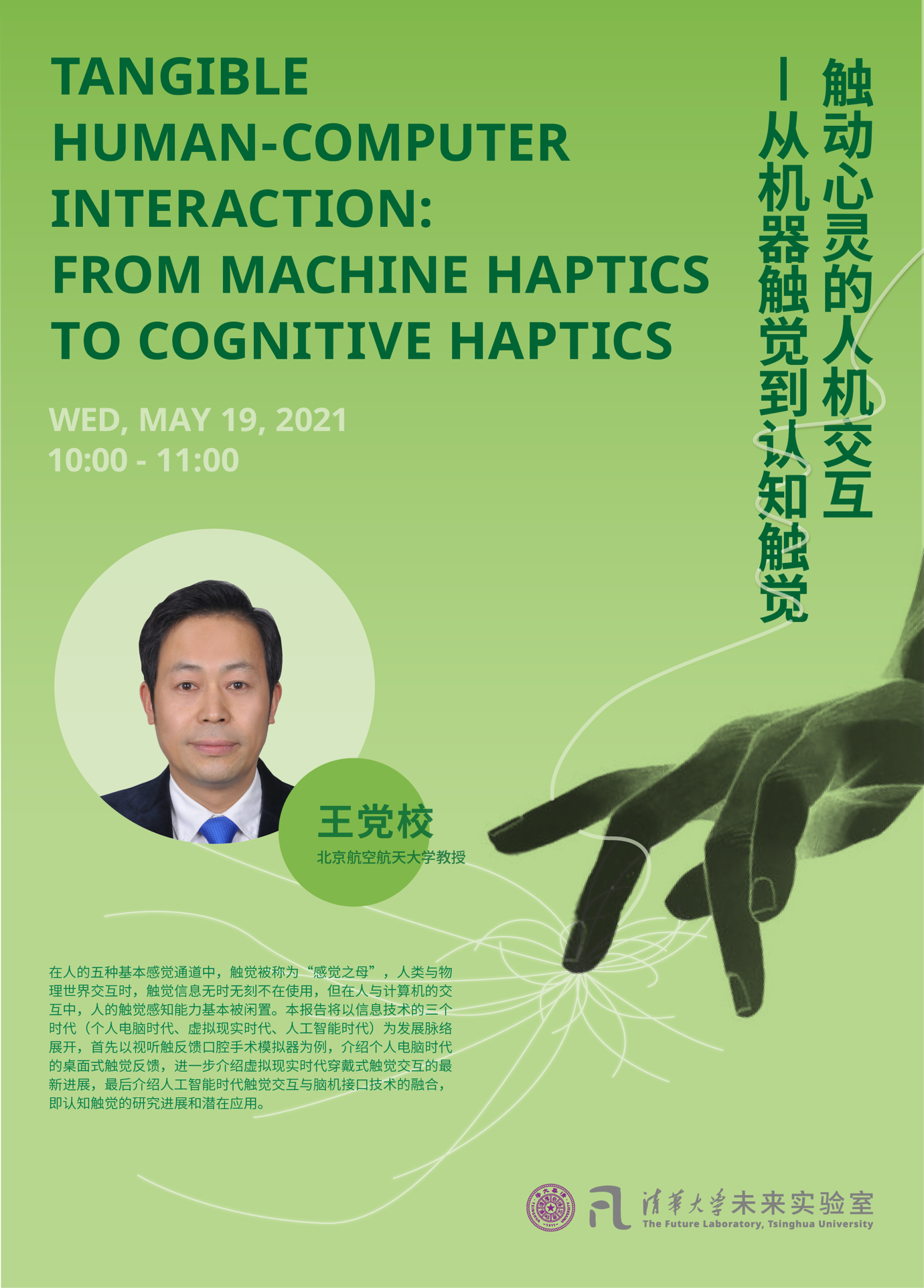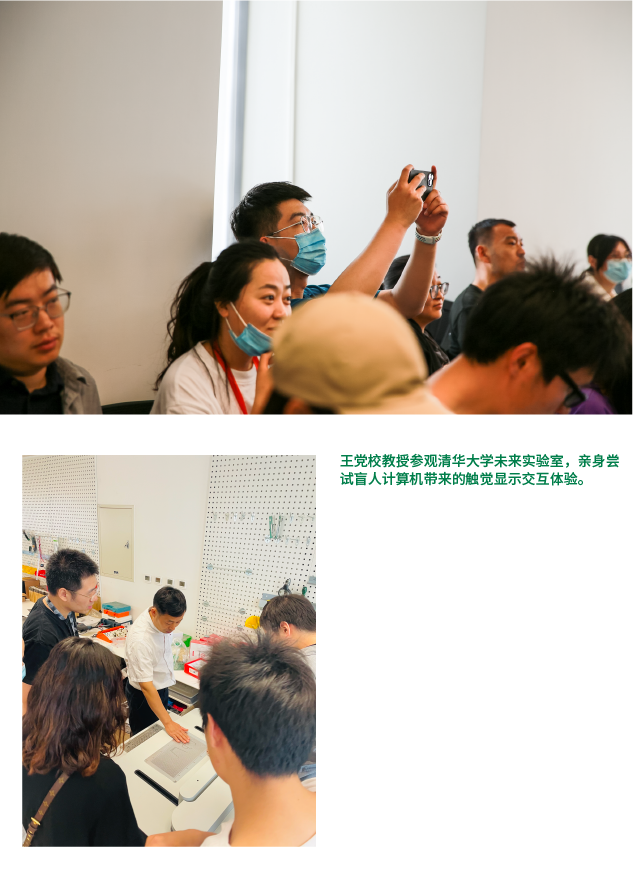Dang-xiao Wang, Professor from Beijing University of Aeronautics and Astronautics explains haptic cognition and human-computer interaction in detail through case studies. This report uses the three eras of information technology (the era of personal computers, virtual reality, and artificial intelligence) as a framework. Firstly, introduce the desktop haptic feedback in personal computers using the audiovisual haptic feedback oral surgery simulator as an example. Then, the latest advances in wearable haptic interaction in the virtual reality era and the integration of haptic interaction with brain-computer interface technology in the artificial intelligence era, i.e., cognitive, are introduced. Finally, Professor Wang introduced the research progress and potential applications of haptics in the era of artificial intelligence and brain-computer interface technology, i.e., cognition.

Lecture Abstract
Among the five basic sensory channels of human, touch is called the "mother of senses", and tactile information is used all the time when humans interact with the physical world. This report uses the three eras of information technology (the era of personal computers, virtual reality, and artificial intelligence) as a framework. Firstly, introduce the desktop haptic feedback in personal computers using the audiovisual haptic feedback oral surgery simulator as an example. Then, the latest advances in wearable haptic interaction in the virtual reality era and the integration of haptic interaction with brain-computer interface technology in the artificial intelligence era, i.e., cognitive, are introduced. Finally, Professor Wang introduced the research progress and potential applications of haptics in the era of artificial intelligence and brain-computer interface technology, i.e., cognition
Prof. Wang Dangxiao
Dang-xiao Wang is a Professor, Deputy Director of State Key Laboratory of Virtual Reality Technology and System and Deputy Director of Institute of Robotics at Beijing University of Aeronautics and Astronautics, and a supervisor of doctoral students. He is a visiting scholar at Stanford University, Karolinska School of Medicine, Sweden, and the University of North Carolina, USA. He has served as the general chair of AsiaHaptics 2020, chair of IEEE Haptics Technical Committee, associate editor of IEEE Transactions on Haptics, guest editor of IEEE Transactions on Industrial Senior Member of IEEE, senior member of Chinese Computer Society, senior member of Chinese Mechanical Engineering Society. He is a member of the Standing Committee of the Human-Computer Interaction Committee of the Chinese Computer Society.
His research areas include machine haptics, cognitive haptics, brain-computer interaction, and medical robotics. He has published more than 30 IEEE Transactions papers as first and corresponding author, and one Springer monograph in English. He received the First Prize of Technical Invention from the Ministry of Education and the First Prize of Science and Technology Progress Award from the Chinese Institute of Electronics. Nominated for best paper in IEEE International Conference on Robotics and Automation (IEEE ICRA 2011), a top international conference in robotics and automation, and nominated for best paper in EuroHaptics 2016, a well-known conference in haptics. Best Paper Award, National Conference on Human-Computer Interaction (CHCI 2020).
Lectue Summary

Haptics is the basis of human perception and movement, and human interaction with the physical world is always dependent on tactile involvement and fine muscle control. However, in the traditional human-computer interaction paradigm, the haptic perception channel is largely unused. The two core scientific questions that Prof. Wang's team is working on are:
the use of machines to provide tactile stimuli on the skin surface, and the development of tactile rendering algorithms for fine manipulation to "take over" and "trick" the human haptic receptors (machine haptics). 2. Exploring the use of haptic interaction as a means of observing and modulating the human brain to facilitate fundamental theoretical research on the plasticity of cognitive mechanisms in the human brain (cognitive haptics).
The development of machine haptics has gone through the desktop haptic device stage in the era of personal computers, the screen haptic device stage in the era of mobile devices, all the way to the wearable haptic device stage in the era of virtual reality and artificial intelligence. Compared to the haptic needs based on operation in the first two stages, the instinct of human haptic interaction is activated when faced with an immersive virtual environment. The medium to achieve haptic rendering will gradually shift from the existing rigid, heavy exoskeleton devices to lightweight, flexible wearable devices. In the future, perhaps "band-aid" type of new materials will help to achieve a more "hidden", so that the user can barely perceive the haptic interaction interface.
In the area of cognitive haptics, Prof. Wang's team focuses on the frontier theoretical exploration and technological development from artificial intelligence to intelligence augmentation. Based on the importance of fine manipulation and tool use for brain plasticity, brain-computer haptic interaction provides a new paradigm for cognitive observation and training of the brain. The team uses "neurofeedback controllability theory" to introduce automatic control theory into the field of haptic cognitive science. Also, using virtual reality environment and customized fine motor to achieve precise target regulation and control of human brain perception-cognitive state. Potential applications include neurorehabilitation, cognitive reinforcement, and plastic learning.
With the development of theories, technologies and devices related to haptic interaction, digital objects in the virtual world will become touchable and machines (robots) in close contact with people in the physical world will become more pliable and safer - a more natural future for human-computer interaction.





